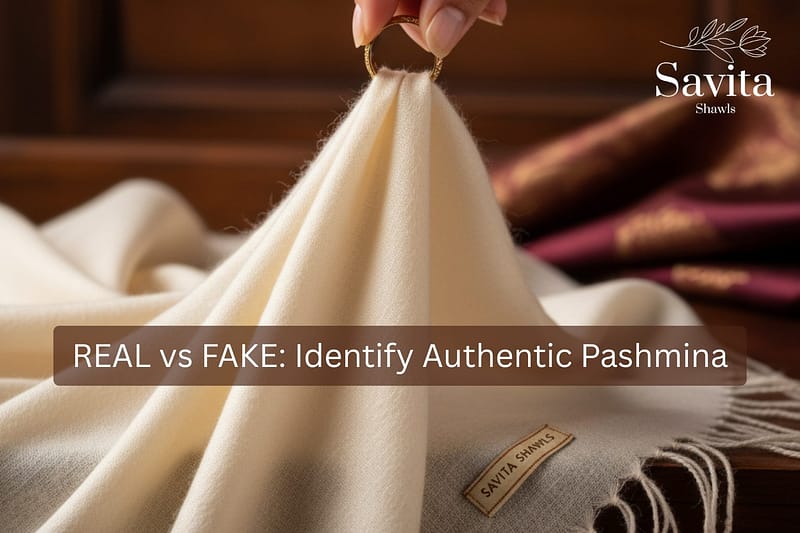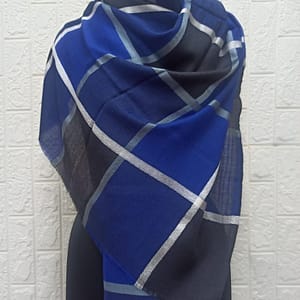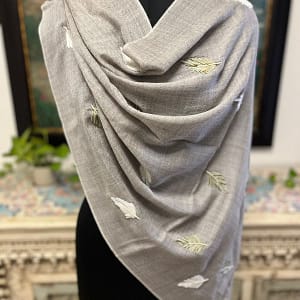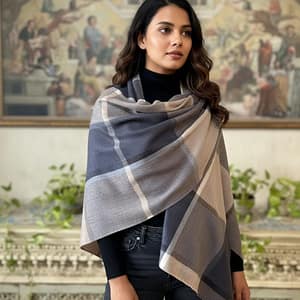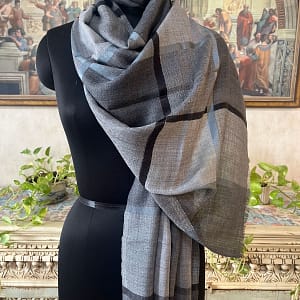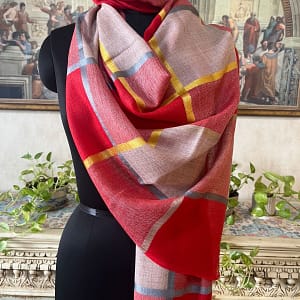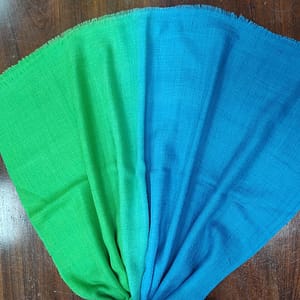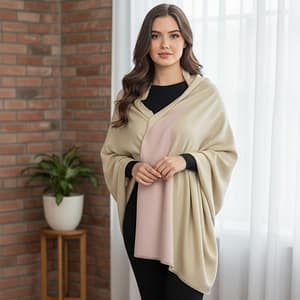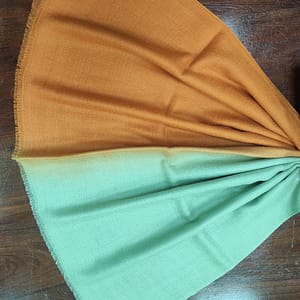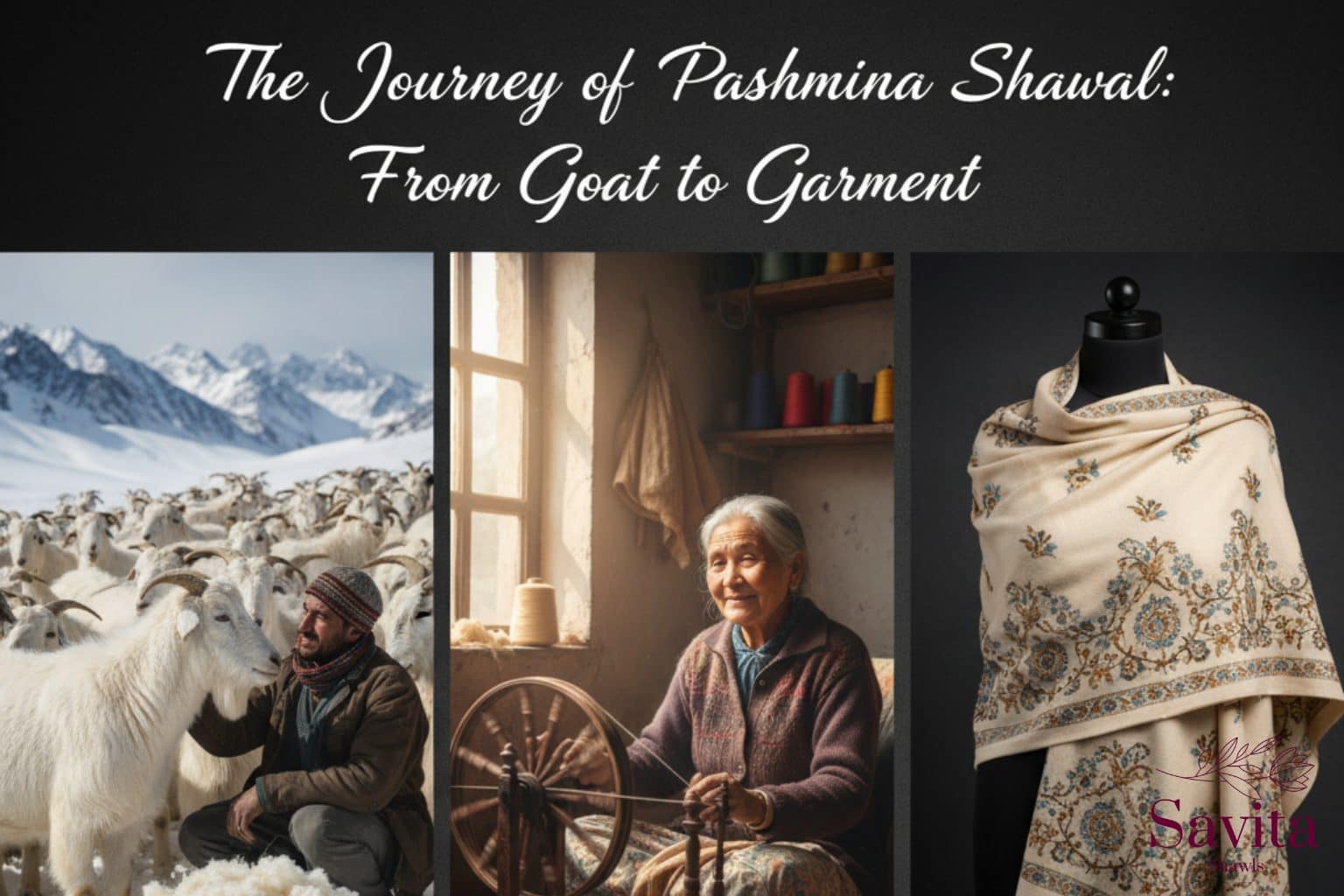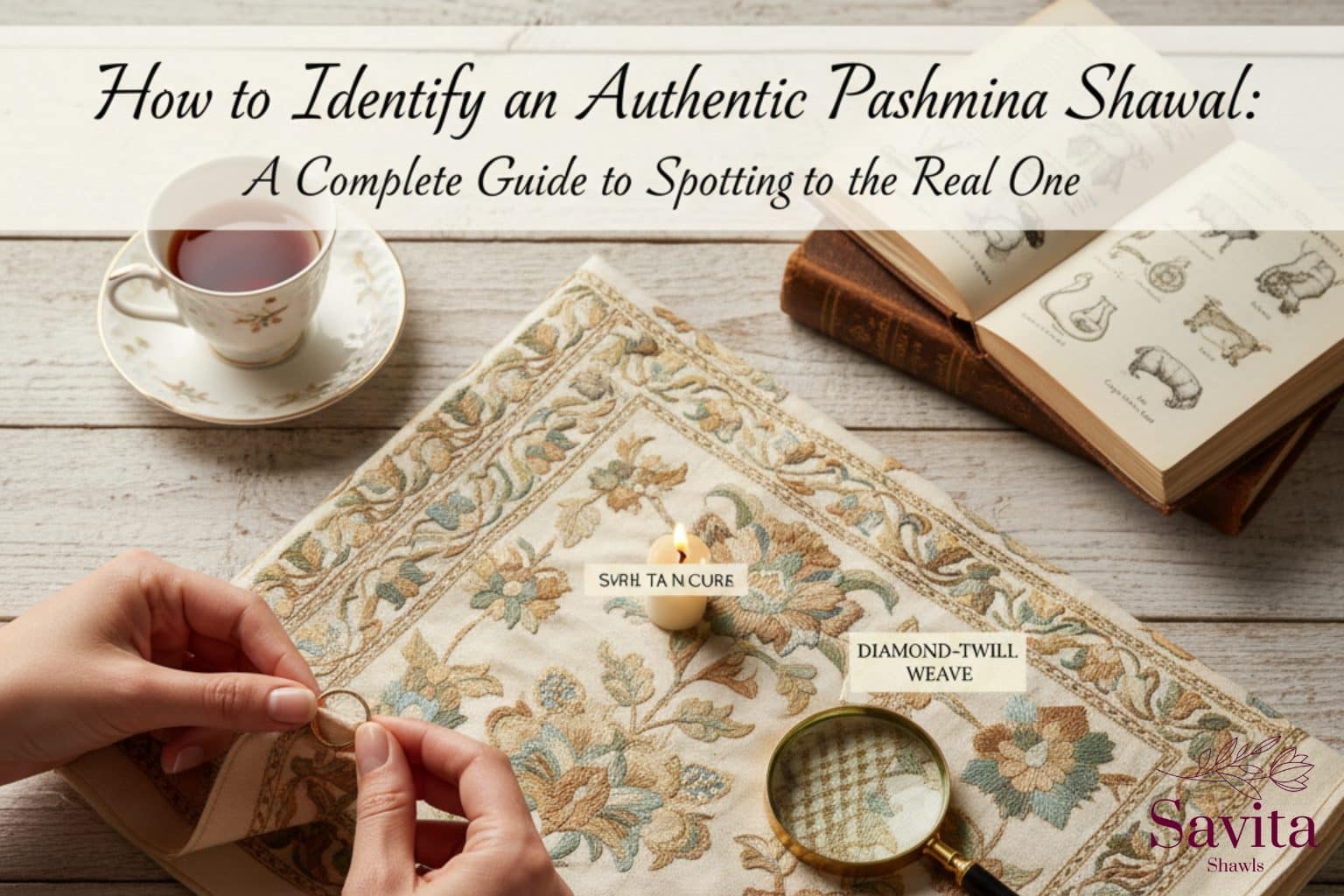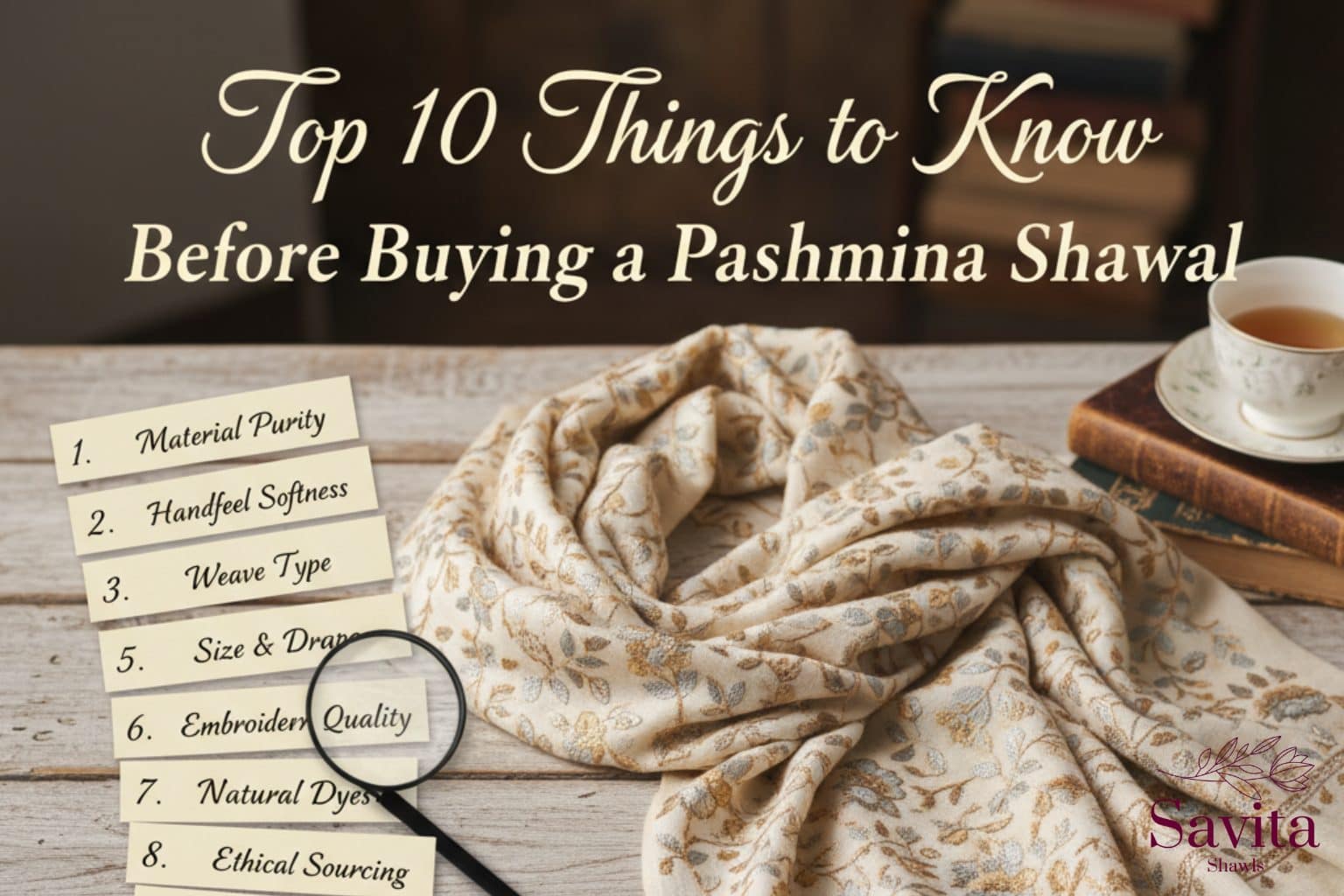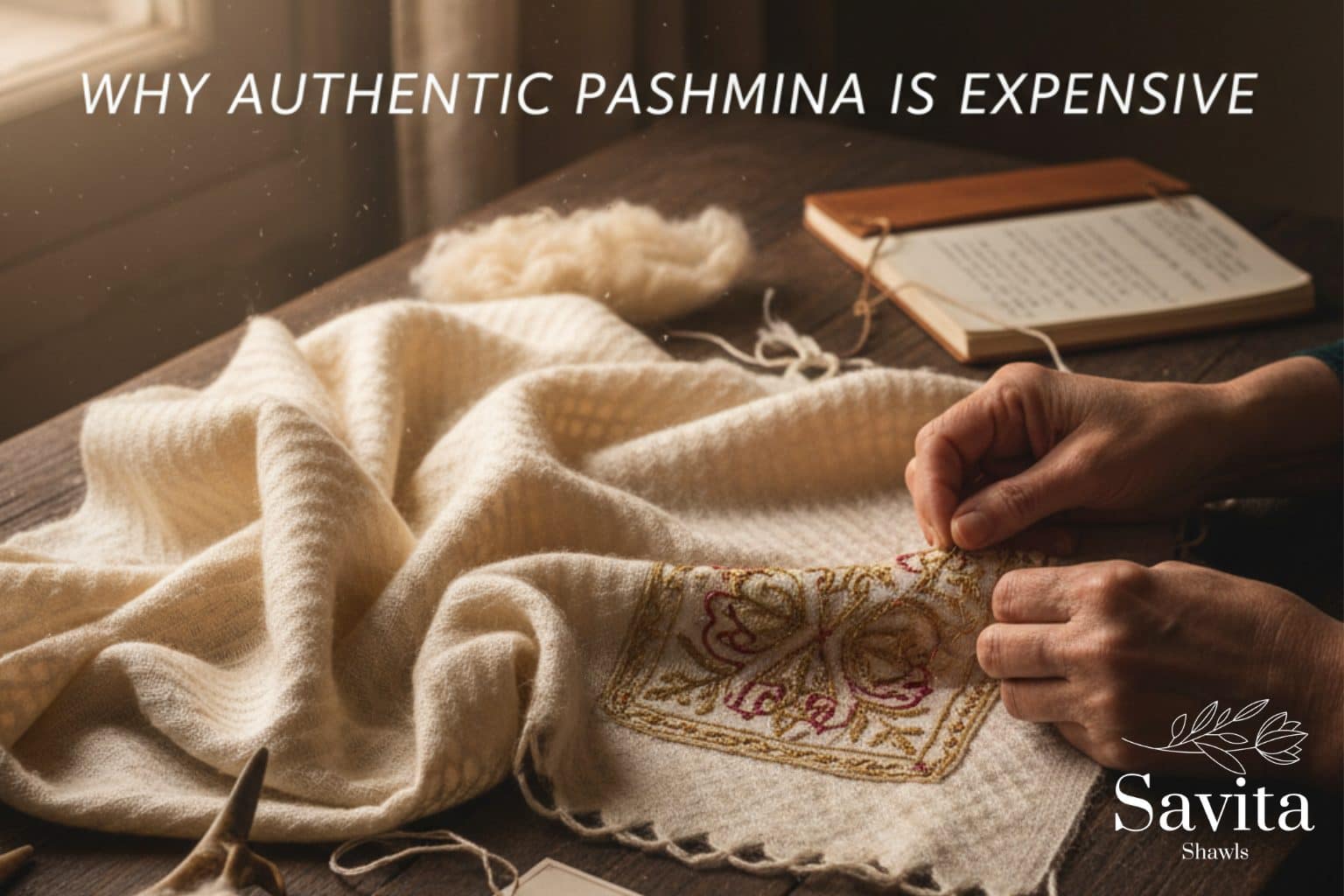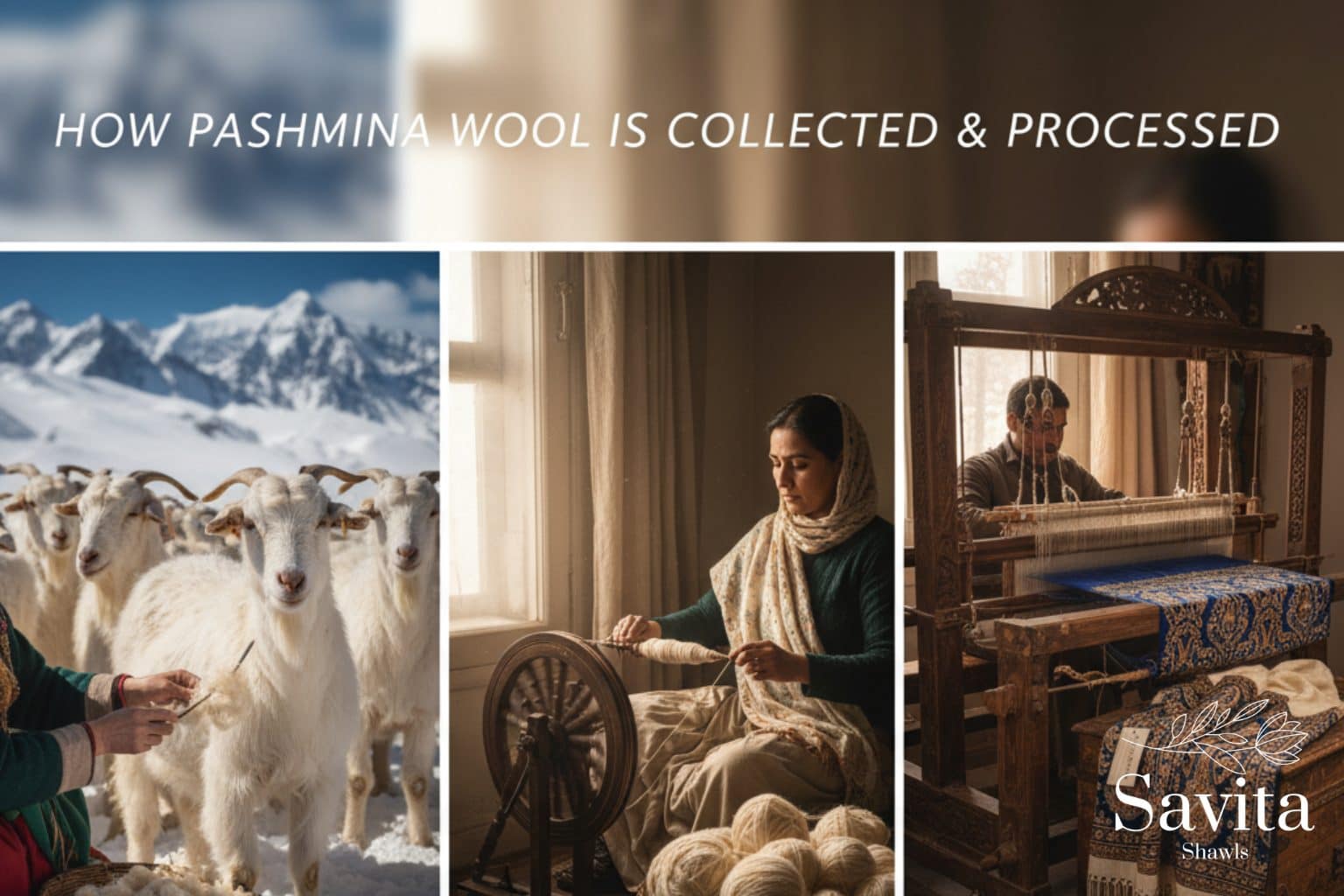Why Identifying a Real Pashmina Matters
A Real Pashmina Shawl is not just a winter accessory but a timeless treasure made through love, patience, and history. Every Real Pashmina Shawl are Kashmir’s souls; they come from majestic Himalayas where Changthangi goat lives, to the node where skilful artists are creating warmth and beauty through the very fine delicate fibres.
A True Pashmina Shawl, known as “Soft Gold of the Himalayas,” embodies the artistic and cultural pride of ages. The making of a Real Pashmina Shawl is unbelievably complex—the wool is hand-combed from the Changthang goat’s undercoat, hand-spun into the finest thread, and then woven by Kashmiri craftsmen on traditional looms. Each masterpiece takes months, sometimes even years, to produce—a true manifestation of human talent and perseverance.
Sadly, however, the world demand for Pashmina has grown tremendously, and with it, the market has also been inundated with Fake Pashmina products. Many dealers resort to the use of synthetic fibres like viscose, polyester, or blended wool and promote them as “Pashmina.” These imitative products may superficially resemble the Real Pashmina but invariably fail every authenticity test—they are unable to provide the softness, breathability, and warmth characteristics that a Real Pashmina Shawl posseses. This not only confuses customers but also negatively impacts the authentic artisans who have dedicated themselves to keeping the Pashmina weaving tradition alive.
Choosing to identify and buy a Real Pashmina Shawl means you are doing a lot more than just acquiring an element of clothing—you are paying respect to a legacy that has lasted for centuries. Real Pashmina weaving is a holy art that has been passed down through generations and is the very essence of Kashmiri culture.
The significance of recognizing an Authentic Pashmina cannot be overemphasized:
- Protect Kashmiri Culture: Real Pashmina Shawls are constantly made by artisans and the craft of weaving is kept alive with every shawl that you buy.
- No Compromise on Quality: A Pashmina from the source is a soft, strong, and wonderfully classic-decorative item.
- No Other Comfort Like This: A real pashmina shawl’s warmth is naturally, and comfortably, not to say, no synthetic imitation can ever be so.
- Natural Luxury: A genuine pashmina shawl is friendly to nature, skillfully woven, and comprised entirely of natural fibers.
A genuine Real pashmina shawl is not only a piece of fabric but also a narrative — a narrative about the purity of the Himalayas, the mastery of the artisans, and the elegance of nature. The only protection for both your investment and a priceless heritage in the present fake world is knowing the difference between the authentic and the fake Pashmina.
The simple yet powerful Pashmina tests as well as identification methods that can aid you in confidently recognizing a Real Pashmina Shawl are presented in the subsequent sections — so that every piece you own is wrapped in its true beauty, warmth, and authenticity.
The Touch and Texture Test: How to Identify a Real Pashmina Shawl
An individual’s tactile sense and texture perception are among the most straightforward but truly dependable methods of discerning a Real Pashmina Shawl. The touch of the authentic Pashmina is an experience beyond the comparison with any other textile; it is a combination of softness, warmth, and extravagance of lightness that possesses a particular appeal which is simply not possible to produce in the case of machine-made or synthetic ones. When you get to handle a Real Pashmina Shawl, it is like you are actually touching a part of a very soft cloud—smooth, light, and so otherworldly.
The following points explain how to check in detail the touch and texture trial:
Softness and Feel
The top quality Pashmina is made from Changthangi goat wool, recognized for its supreme softness. It abounds in cuddliness and exudes no slipperiness or glossiness at all. On the contrary, fake or machine-made versions, which most probably are mixed with viscose or polyester, have a shining outer layer and are too soft to the touch. The authentic Pashmina gives off a mild, natural, and very fine smoothness that is pure and organic against the skin.
Tip: Let the Real Pashmina Shawl rest on your cheek; if it gives a soothing and warm feeling very quickly, it is probably natural. On the contrary, synthetic shawls would feel a bit cold or artificial.
Warmth Without Weight
The real Pashmina wraps you up in warmth without any bulkiness. The ultra-fine strands of the shawl are so fine that they are almost invisible and thus trapping body heat efficiently, and making you feel comfortable even in winter. You may find it surprising that even one layer of Pashmina contains the ability to provide insulation like that of synthetic fibres three times their weight.
Light weight warmth is the trade mark of the authenticity of the garment and the most powerful reason is the skill of the Kashmiri craftsman that Real Pashmina Shawls are so highly valued throughout the world.
Natural Texture Variations
As every genuine Pashmina Shawl is woven entirely by hand on old wooden looms, you might be able to see very slight differences in the weaving or the texture. However, these small discrepancies are not flaws at all — on the contrary, they’re signs of authenticity. Every piece is a witness of the painstaking effort and skilled talent of the craftsman. A machine-made shawl will appear to be very uniform and perfect, whereas a real Pashmina shawl will have an exquisitely natural and varied surface.
The Finger Rub Test
Take the fabric and very lightly rub it between your fingers. An authentic Pashmina Shawl will have a soft and a bit fuzzy feeling because of the fine wool fibres. It will also give the most delicate warmth as your fingers move over it. On the other hand, non-authentic or blended shawls might feel like plastic, very smooth or even lifeless – they would not possess the natural warmth and texture of real Pashmina.
Matte vs. Glossy Appearance
A Real Pashmina Shawl often has a very light matte finish that is very classy and stylish. The fabric’s main virtue is its elegance — not its brilliance. If your shawl has a very bright, sticky, or heavily reflective appearance when compared to other shawls, it might be a plastic copy.
Final Tip: The senses are your best allies. The very touch, warmth, and slight fuzziness of a genuine Pashmina shawl are sure indications of its being real. Once you have experienced a true one, you will be able to differentiate it from a counterfeit one easily forever.
| Feature | Real Pashmina Shawl | Fake/Synthetic Pashmina |
|---|---|---|
| Texture | Soft, slightly fuzzy, natural warmth | Too smooth, plasticky, or slippery |
| Finish | Matte and elegant | Shiny or glossy appearance |
| Warmth | Naturally warm without heaviness | Little or no warmth |
| Weight | Feather-light | Often heavier or stiff |
| Weaving | Handwoven with slight irregularities | Machine-made with uniform texture |
| Feel Test | Warm, buttery soft | Cold, artificial to touch |
| Durability | Improves with use and care | May pill or lose shape quickly |
| Origin | Made from Changthangi goat wool (Kashmir) | Made from viscose, acrylic, or polyester |
The Burn Test for Authenticity: Identify a Real Pashmina Shawl
The Burn Test is among the most ancient and most accepted methods to identify a Real Pashmina Shawl vs. a Fake one. Today, if you have access to modern technology or an expert, then they could assist you with the process but still this simple old method gives quick and visible results. Of course, the process must be very careful and only a small thread must be used in order not to damage your precious Real Pashmina Shawl.
The test is accurate because the reactions of natural fibres like Pashmina wool are very different from those of synthetic materials when they are set on fire. The fibre’s smell, residue and texture act as clues as to whether you are in possession of an original piece of art or a factory-made duplicate.
How to Perform the Burn Test on a Real Pashmina Shawl
Step 1: Pull Out a Tiny Fibre
Carefully detach a single loose fibre or a very thin thread from an unnoticeable edge of your Real Pashmina Shawl. This way, the main part of the shawl will not be damaged at all. A large sample is not needed — even a thread a couple of centimeters long will suffice.
Step 2: Use a Matchstick or Candle Flame
Do not forget to use a pair of tweezers or a safety pin to hold the fibre. Slowly bring it to the flame, which should be a matchstick or candle. Keep watching how it reacts right from the start when it makes contact with the flame.
Step 3: Watch Closely and Notice the Reaction
Now is the time for the fun part — the fibre’s reaction reveals a lot about whether your shawl is genuine or counterfeit.
What the Results Mean
If It’s a Genuine Pashmina Shawl:
- The fiber will take a long time to burn and will give off an odor similar to that of burnt hair or feathers.
- The residue after burning will be a soft, fine, and crushable ash.
- The fire will go out right away as soon as you take the fiber away.
- This odor is due to the fact that a Real Pashmina Shawl is made of animal fiber (the soft undercoat of the Changthangi goat) which is a natural fiber.
All these are the strong and certain indications that your Real Pashmina Shawl is an authentic one and also made from the finest wool fibers.
If It’s a Fake or Synthetic Pashmina:
- The fiber will either melt or shrink instead of burning cleanly.
- The odor will be like burnt plastic or rubber · this is an obvious sign of synthetic fibers such as acrylic or viscose which are commonly used in the manufacture of fake Pashmina.
- Once cooled down, it will leave behind hard, bead-like residues instead of the soft ash.
- These are the materials that are often used in producing fake Pashmina imitations which are then sold at lower prices.
Important Safety and Care Tips
- The Burn Test should always be performed with the utmost caution as fire can easily destroy the exquisite fabric of a Real Pashmina Shawl.
- Take just one small loose fiber from the corner or the back of the shawl for testing.
- If you have doubts, it’s better to have the shawl tested by an experienced Pashmina connoisseur or a skilled artisan who can do it safely.
- Do not, under any circumstances, burn a sizable part of your Real Pashmina Shawl because it might lead to the destruction of the whole piece.
Expert Insight:
The Burn Test is very reliable because it gives direct proof of what your shawl is made of, whether it is natural Pashmina wool or some man-made substitutes. Burning gives off the smell of hair and leaves the soft ash as the only witness, the latter being one of the signs of genuineness, which no synthetic fabric can replicate.
If you use this test in conjunction with the other methods like the Touch and Texture Test and Weave Inspection, you will be able to pinpoint the Real Pashmina Shawl with complete confidence and thus safeguard yourself against fake products.
Comparison Table: Real Pashmina Shawl vs. Fake Pashmina (Burn Test Results)
| Feature | Real Pashmina Shawl | Fake/Synthetic Pashmina |
|---|---|---|
| Burn Behaviour | Burns slowly and evenly | Melts or shrinks quickly |
| Smell | Like burnt hair or feathers | Like burnt plastic or chemicals |
| Residue Type | Soft, fine, crushable ash | Hard, bead-like lumps |
| After Flame Removed | Stops burning immediately | Continues melting or burning |
| Texture After Burn | Turns to powdery ash | Becomes sticky or rubbery |
| Fibre Type | Natural animal wool (Changthangi goat) | Synthetic materials (viscose, acrylic, polyester) |
| Authenticity Proof | Confirms natural and handmade origin | Indicates fake or blended material |
Fibre Thickness and Weave Pattern
An Authentic Pashmina Shawl shows off its splendour through its thin fibre and handwoven texture.
What to look for:
- Microscopic Fibre Diameter: Actual Pashmina fibres are around 12–16 microns thick — considerably thinner than ordinary wool.
- Weave Pattern: The real ones are handwoven on antique wooden looms that render a pattern with slight irregularities which contribute to their beauty.
- Flexibility: The fabric has a beautiful fall and gives the impression of being very light, almost like a feather.
Machine-made or mixed shawls will have an even weave and will not possess the natural imperfections resulting from the skill of the artisan.
The Label and Craftsmanship Check
Usually, genuine Pashmina shawls come with labels or certifications declaring their authenticity. If you are in search of a Real Pashmina Shawl, then label checking is very important:
- GI (Geographical Indication) Tag: Only the original Kashmiri Pashminas get this tag, and it proves that the product is genuinely made from the wool of Himalayan Pashmina.
- Brand Label: Reputable sellers such as Savita Shawls assure good transparency in the labelling with identification of the fibre content.
- Handcrafted Detailing: Pay attention to the embroidery — genuine Kashmiri handwork (such as Sozni or Kani) reveals elaborate patterns created by master artisans.
Expert Tip: “100% Pashmina” is the label on the product, but if the price appears to be very low, then probably it is not real. Genuine Pashmina requires several months of weaving and is fairly priced according to its quality.
Common Signs of Fake Pashmina Shawls
It is difficult to discern a counterfeit Pashmina amongst the numerous replicas available in the market. Nonetheless, the following signs are clear giveaways that should provoke doubt:
- Excessively glossy surface (caused by a mix of silk or synthetic fibers)
- Uniform patterns made by machines
- An astonishingly low price for a product with a “Pashmina” tag
- Silky feel devoid of any fuzziness or warmth
- No or vague information about the place of origin
Do not forget. A genuine Pashmina is always slightly off-balance in symmetry — its small flaws are the testament to the craftsmanship behind each weaving.
Expert Tips from Savita Shawls
Savita Shawls has been keeping the tradition of making shawls by hand alive for many years. Our specialists give the following advice to help people make the right choice when they are buying a Real Pashmina Shawl:
- Buy from reliable sources – only well-known brands can provide the right certification.
- Know the price – genuine Pashmina is very costly as it is hard to find and requires a lot of manual work.
- Look for craftsmanship – exclusive Kashmiri embroidery or weaving patterns are sometimes very similar to the particular shawl.
- Inquire about fiber composition – the retailers of real Pashmina will always be open and forthcoming regarding the source of the fibers.
Savita Shawls takes pride in its Authentic Pashmina collections that are made by expert Kashmiri artisans, thus each shawl is not only a luxury item but also a piece of heritage.
Final Thoughts: Choose Authenticity
A genuine Pashmina Shawl is a representation of Himalayan history — an integration of heat, tenderness, and craftsmanship that is unparalleled. The market is swamped with counterfeit Pashmina, but by simply knowing these few identification methods you will not only be able to ward off imitations but also invest in something that will last forever.
We at Savita Shawls invite you to go for the genuine, back the highly-skilled artists, and feel the wonder of real Pashmina—made with affection, endurance, and customs.
Related Products
Showing 1–9 of 805 results
-
Savita Shawls Royal Blue & Black Wool Natural Silk Box Pashmina Shawl for Women
Read more -
Savita Shawls Elegant Grey & Black Wool Natural Silk Box Pashmina Shawl for Women
Read more -
Beige & Charcoal Wool Natural Silk Box Design Pashmina Shawl for Women
Read more -
Yellow & Navy Wool Natural Silk Box Design Pashmina Shawl for Women
Read more -
Grey & Black Wool Natural Silk Box Design Pashmina Shawl for Women
Read more -
Red & Beige Wool Natural Silk Box Design Pashmina Shawl for Women
Read more -
Green & Blue Wool Natural Ombre Pashmina Shawl for Women
Read more -
Beige & Soft Pink Wool Natural Ombre Pashmina Shawl for Women
Read more -
Rust Orange & Mint Green Wool Natural Ombre Pashmina Shawl for Women
Read more

